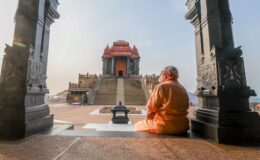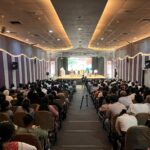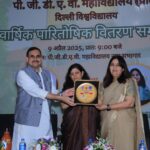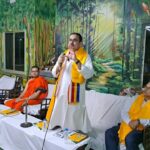FESTIVAL OF CULTURE AND SPIRITUALITY
- By : Anirban Ganguly
- Category : Articles
The intrinsic message of the Hindu Service and Spiritual Fair is that Hindu society must address contemporary challenges through a definite civilisational approach
Melas or fairs have, in the near past, played a pivotal role in India, especially in support of movements for national regeneration. The celebrated Hindu Mela in Bengal in the 1860s instilled a sense of pride and self-hood among Hindus and was an early contributor to the crystallisation of the nationalist movement in India.
One of the progenitors of the Mela, Nabagopal Mitra, saw the religio-cultural congregation as a most potent instrument for national unity and for the spread of nationalism. His efforts received adherence from some of the most dynamic minds of the period. Rajnarayan Bose, Sri Aurobindo’s maternal grandfather, one of the greatest minds of Bengal, often referred to as the “grandfather of Indian nationalism” became the principal collaborator in this project. To him can be attributed the effort of turning back the tide of deracination that had been initiated and taken to extreme lengths by the young Bengal movement.
In his admirable study, Indian Nationalism: Its principles and personalities (1918), BC Pal, discussing the Hindu Mela, noted that Rajnarayan Bose, seeing the “on-rush of European goods into Indian markets, tried to stem the tide by quickening what we now call the Swadeshi spirit, long before anyone else had thought of it. It was under his inspiration that a Hindu Mela or National Exhibition was started a full quarter of century before the Indian National Congress thought of an Industrial Exhibition.”
The sixth Hindu Service and Spiritual Fair to be held between July 8 and 14 in Chennai with its core message of the blending and converging of ‘Desam, Deivam, Dharmam’ (Nation, Divinity and Hindu Value System) brings back a sense and shade of that past attempt. A unique collective effort to present the various strands and threads of Hindu action, and within them reveal a deeper underlying unity, the Fair, a veritable civilisational confluence shall see hundreds of Hindu religious and cultural organisations participate. It holds, as one of its fundamental aims, the dispelling of the reductionist notion that “Hinduism is a mere spiritually oriented religion bereft of services and not sensitised to serve the society that needs care and concern.” The principal aim of the Fair is to dispel that motivated misconception by providing a platform for Hindu spiritual organisations to come together to “showcase the services rendered by them in various fields to the people in different walks of life and other living beings and to promote a spirit of service in them.”
The HSSF theme of “connecting Hindu spirituality to contemporary challenges” is a need for our times. The six thematic pillars of this Fair cover the entire gamut of the broad fundamental challenges to Hindu society and to the nation. Conservation of forests and wildlife (Vruksha Vadanam), ecological preservation (Go-Gaja-Tulsi Vandanama), environmental sustainability (Ganga-Bhoomi Vandanam), inculcation of family and human values (Maatru-Pitru-Acharya Vandanam), fostering of women’s honour (Kanya, Suvasini Vandanam) and promotion of patriotism (Bharat Mata Vandaman) are these six themes which the congregation seeks to bring about a realisation of that past harmonious and collective living, evolved over the millennia by the upholders of our thought and civilisation and its utility in addressing contemporary challenges.
One of the highlights of the Fair is the coming together of spiritual leaders of Hinduism, Sikhism, Buddhism and Jainism for its inauguration, demonstrating the underlying unity of a deeper faith, belief and goal. A veritable festival of civilisation, culture and spirituality, the Fair’s intrinsic message is that of the need for Hindu society to address contemporary challenges through a civilisational approach. It is in such an approach alone that lay the possibilities and hope of a perpetual living.

















